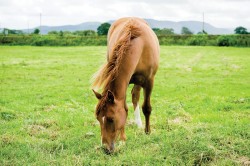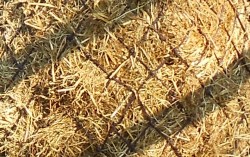The horse is a grazing animal, which has naturally evolved to consume forage in order to survive. This forage provides our horses
with a natural source of protein, carbohydrates, vitamins and fibre in a format that is easy and efficient for our horses to digest. This fibre provides slow release energy for the horse, which makes it an ideal energy source for fizzy, excitable horses, unlike the quick release energy supplied by cereals.
Fibre is a generic term referring predominately to forages such as grass, hay and haylage, but also includes alternative ‘forage replacer’ products such as high fibre pellets, alfalfa and grass cubes and short chop forages. Forages (grass/hay/haylage) tend to make up the bulk of our horse’s diet, but the alternative sources can be useful, such as when grass, hay or haylage is lacking in quantity or quality or when there is a specific dietary problem, such as lack of teeth in veterans or a requirement for a strict low calorie diet.

Why do horses need forages such as grass, hay and haylage?
Unlike concentrated cereal based feeds, forages such as grass and hay are what the equine species have evolved to eat. In the wild, they would have had free access to a wide variety of forages, eating little and often throughout the day. Today’s equine is managed in a very different way to their ancestors, with limited grazing and space, however their anatomy is still designed to work in this same ‘little and often’ or ‘trickle feed’ routine. Due to this trickle feeding legacy, your horse is equipped with an inbuilt desire to chew for a large part of his day. Chewing forage satiates this innate need and the increased chewing time it requires stimulates saliva production and slows down the rate at which the food reaches the stomach, ensuring the horse’s need to trickle feed is met while the high fibre content keeps the digestive system healthy and mobile.
However without sufficient forage the horse can develop both health issues and abnormal or stereotypical behaviours such as; cribbing, weaving, manure eating and wood chewing as they seek out satisfaction through destruction of their surroundings! Though we as horse owners may feel frustrated with our horse for this behaviour or think they are simply being naughty, it may be well worth considering the amount of forage we are providing our horses before we blame disobedience. More crucially, reduced proportions of forage in the diet can have highly damaging effects on the health of the equine digestive system. This is because the equine stomach produces gastric acid continually regardless of whether it contains food or not. So when our horse’s mouths are empty, the stomach acid produced is not neutralised by the saliva, which is stimulated by chewing. Lack of neutralisation of this stomach acid can cause the equine gut to become acidic in its pH leading to health problems such as colic and gastric ulcers.

While the type of forage that our equine can eat may vary, what is important for dietary wellbeing is that our horse or pony receives enough forage to keep the gut healthy. An absolute minimum of 1% of your horse’s bodyweight is required as forage to keep his digestive system healthy and help prevent digestive upsets such as colic. When fed ad lib forage, intakes are typically in the range of 2 – 2.5% of bodyweight.
What should we do?
So as forage is the most important aspect of our horse’s diet, providing good quality and sufficient quantity of it is vital for our horse’s welfare. Regular turnout and good quality hay or haylage is a must for a healthy, happy horse.
Sometimes providing sufficient quality forage and grass can prove tricky as the opportunity for our horses to constantly graze is often impossible in today’s equestrian world. Nowadays our pastures are far cry from the nutrient rich pasture that our horse’s ancestors consumed. Grass, hay and haylage can be lacking in many essential nutrients that are vital to maintain optimum health in your equine. Supplementation of the diet therefore becomes essential in order to ensure they receive all the vital vitamins, minerals and trace elements they require to maintain peak health. This is where offering a free-access, palatable nutrient rich lick can assist. Horslyx provides a cost effective and simple way to balance your horse’s natural, forage based diet and has been designed to complement the deficiencies often found in grazing in the UK. The palatable lick contains a comprehensive vitamin, mineral and trace element package alongside vital anti-oxidants to support the immune system, oil to benefit the skin and coat and biotin, methionine and chelated zinc for healthy hooves.

The chart above demonstrates the importance of supplementing the diet with a product such as Horslyx, to balance the deficiencies in forage and grazing.
